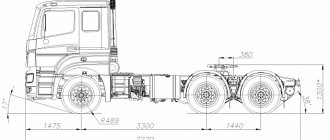Mercedes Sprinter is a reliable, safe and comfortable car designed for transporting passengers and cargo both around the city and in the suburbs. It is assembled at the German plant in Ludwigsfeld. Sprinter Classic has excellent capacity and resistance to difficult operating conditions, which attracts companies involved in cargo transportation.
Good visibility and controllability are some of the advantages of this model.
The technical characteristics of a Mercedes Sprinter are what any car driver looks at first, that is, fuel consumption, engine features, power, etc. This is what keeps you productive.
Mercedes-Benz Sprinter Classic – review and technical specifications
Navigation
- Those. characteristicsGenerationsNewsVideoCompetitorsGo back
The popular Russian light-duty car Mercedes-Benz Sprinter Classic keeps up with the times and the desires of its consumers.
After 5 years of impeccable work, the car was transformed in appearance and received advanced equipment already in the basic configuration. The car boasts an improved and functional design on the outside, reduced noise levels and fuel consumption, and a more thorough approach to the comfort of the driver and the cargo being transported. The Sprinter Classic van has proven itself to be a reliable partner in a wide range of applications. It is available in two lengths and comes with a high roof as standard.
Average body length:
- Length 5640 mm
- Width 1933 mm,
- Height up to 2595 mm,
- Wheelbase 3550 mm,
- Loading length 3265 mm,
- Loading area 5.20 m2,
- Useful volume 10.40 m3,
- Load capacity 1435 kg,
- Full standard weight 3500 kg,
- Full standard weight with trailer 6300 kg
- Length 6590 mm,
- Width 1933 mm,
- Height up to 2610 mm,
- Wheelbase 4025 mm,
- Loading length 4215 mm,
- Loading area 7/6.8 m2,
- Useful volume 13.40 m3,
- Load capacity 1315 kg,
- Full normal weight 3500/4600 kg,
- Full standard weight with trailer 6300 kg
Engine
The updated Sprinter Classic is equipped with a modern 6-speed manual transmission - this innovation has been eagerly awaited by many customers. Thanks to the additional gear (the previous Sprinter Classic had a 5-speed manual transmission), it was possible to reduce fuel consumption, noise levels when driving in higher gears, increase dynamics and, in the future, engine life. Thus, Mercedes-Benz engineers achieved a reduction in fuel consumption by 4.7%. Moreover, the presence of sixth gear made it possible to reduce noise by 2 dB (compared to the figure for the same driving mode in 5th gear).
- Engine OM 646 DE22LA, diesel
- Working volume (cm3) – 2148
- Rated power (kW/hp) – 80/109
- Speed (rpm) – 3800
- Nominal torque (Nm) – 280
- Speed (rpm) – 1600–2400
- Fuel – diesel
- Fuel tank capacity (l) approx. 75
- Fuel system - common rail direct injection with turbocharger, charge air cooling and electromagnetic injectors
- Toxicity standard – Euro 5
- Drive 4 x 2 (rear wheel drive)
313 CDI, 413 CDI
- Engine OM 646 DE22LA, diesel
- Working volume (cm3) – 2148
- Rated power (kW/hp) – 100/136
- Speed (rpm) – 3800
- Nominal torque (Nm) – 320
- Speed (rpm) – 1800–2200
- Fuel – diesel
- Fuel tank capacity (l) approx. 75
- Fuel system - common rail direct injection with turbocharger, charge air cooling and electromagnetic injectors
- Toxicity standard – Euro 5
- Drive 4 x 2 (rear wheel drive)
Safety
The ADAPTIVE ESP® electronic stability control system will keep the Sprinter Classic in its lane when necessary. In addition, the safety system is complemented by anti-lock braking system (ABS) and anti-slip control (ASR), as well as powerful brakes and a driver airbag.
The driver's cabin is highly comfortable, equipped with convenient controls and ergonomic seats and made of durable, high-quality materials. The basic equipment of the Sprinter Classic includes many practical and convenient features, such as a two-seater front passenger seat and remote-controlled central locking.
Workplace overview in Sprinter Classic
- Driver's seat with adjustable height, length and backrest angle,
- Double front passenger seat, headrests with height and tilt adjustment
- Three-point seat belts in front
- Modern 4-spoke steering wheel
- Driver airbag
- Practical additional storage compartment under the front passenger seat
- Powerful heating and ventilation system with low-noise four-stage fan
- Preparation for installing a radio receiver (antenna, cable)
- Central locking with remote control
- Instrument panel with tachometer, clock, trip odometer and trip odometer
- Compartment above the windshield, stowage compartment with lid, paper clip
Verdict
The Mercedes-Benz Sprinter Classic can cope with any task, whether as a van for transporting goods or as a minibus for transporting passengers.
The new model is available at all official Mercedes-Benz van dealers from March 2022. The price of the updated Sprinter Classic starts from 1,697,000 rubles including VAT.
Mercedes-Benz Sprinter engines. Official fuel consumption per 100 km.
Generation 1 (1995-2006)
Diesel:
- 308d, 2.3 l, 79 l. pp., 4-speed automatic, years of production – from 1995 to 1999
- 312d, 2.9 l, 122 l. pp., 5-speed manual, years of production – from 1995 to present. V.
Generation 2 (2007 – present)
- 2.2, 88 l. With. since 2006
- 2.2, 95 l. With. since 2006
- 2.2, 109 l. pp., since 2006
- 2.2, 129 l. With. since 2008
- 2.2, 150 l. pp., since 2006
- 2.2, 163 l. pp., since 2006
- 2.2, 156 l. pp., since 2006
- 3.0, 184 l. pp., since 2006
- 3.0, 190 l. pp., since 2006
- 3.5, 258 l. pp., since 2006
Mercedes-Benz Sprinter >(109 hp)
Add to comparison Compare: 0
- 311 CDI MT L1 Basic (109 hp) RUB 1,605,000
- 311 CDI MT L2 Basic (109 hp) RUR 1,655,500
- 313 CDI MT L1 Basic (136 hp) RUR 1,662,000
- 313 CDI MT L2 Basic (136 hp) RUR 1,712,500
- 311 CDI MT L1 Advanced (109 hp) RUR 1,689,000
- 311 CDI MT L2 Advanced (109 hp) RUR 1,739,500
- 313 CDI MT L1 Advanced (136 hp) RUR 1,746,000
- 313 CDI MT L2 Advanced (136 hp) RUR 1,796,500
Mercedes-Benz Sprinter advertisements
- Equipment and options
- Specifications
Engine
| engine's type | Diesel |
| Number of cylinders | 4 |
| Number of valves per cylinder | 4 |
| Working volume | 2148 cm³ |
| Configuration | Row |
| Maximum power | 109 hp at 3800 rpm |
| Maximum torque | 280 N∙m at 1600 – 2400 rpm |
| Intake type | Direct injection |
| Supercharging | ✓ |
Body
| Number of seats | 3 |
| Wheelbase | 4025 mm |
| Curb weight | 2185 kg |
| Full mass | 3500 kg |
| Load capacity | 1315 kg |
| Gross permissible weight of the road train | 6300 kg |
| Cargo compartment | |
| Length | 4215 mm |
| Height | 1850 mm |
| Volume | 13.4 m³ |
Performance characteristics
| Recommended fuel | DT |
| Fuel tank capacity | 75 l |
| Environmental Compliance | Euro 5 |
Transmission
| Transmission | Mechanical |
| Number of gears | 5 |
| Drive unit | Rear |
Steering
| Amplifier type | Hydraulic |
Country of Origin
| Country of Origin | Russia |
- Equipment and options
- Specifications
Mercedes-Benz Sprinter fuel tank dimensions
The width of Mercedes-Benz Sprinter fuel tanks for all modifications ranges from 100 (l) to 75 (l).
Fuel tank parameters for standard modifications:
2.1 l., Diesel, Mechanical, 5 speed, Rear:
1.8 l., Petrol, Automatic, 5 speed, Rear:
1.8 l., Petrol, Gas, Mechanical, 6 speed, Rear:
Tank characteristics:
The main characteristics of the fuel tank include the following indicators:
- Length (L): overall length at the most protruding parts;
- Width (B): overall width at the most protruding parts;
- Height (H): overall height at the most protruding parts;
- Volume.
Important: detailed parameters of automobile fuel tanks by modification are presented in the table below.
Other names:
The light-duty vehicle (minibus, van, flatbed truck) Mercedes-Benz Sprinter is sold in some countries under the designations Dodge Sprinter and Chrysler Sprinter.
is currently being produced.
Classmates
- Renault Master from RUR 1,759,990
- Citroen Jumper van from RUB 1,959,000.
- Citroen _
- FIAT
- GAC
- HINO
- ISUZU
- J.A.C.
- L LADA
- Mercedes-Benz
- Opel
- Peugeot
- Renault
- Toyota
- Volkswagen
- GAS
- UAZ
Mercedes-Benz Sprinter Classic
The Mercedes-Benz Sprinter Classic can cope with any task, whether as a van for transporting goods or as a minibus for transporting passengers. With more than 1.5 million vehicles sold, billions of kilometers traveled and the inherent longevity of the Mercedes-Benz brand, Sprinter has been a proven and reliable partner in the transport business for many years.
Sprinter Classic is focused on what matters most – your work, and therefore your success. Its exceptional reliability, wide range of uses and high efficiency contribute to this. A powerful, durable engine and a sophisticated safety concept are just as convincing as maximum performance and guaranteed maintenance. This is exactly what you can rightfully expect from a Mercedes-Benz van.
Mercedes Sprinter real fuel consumption per 100 km: reviews
Generation 1
- Vitaly, Orsk, 79 l. With. I have a Sprinter purely for work, they provided me with the 1997 version, with 79 hp. diesel. In the end, I am satisfied with the machine; it is a practical workhorse, with an energy-intensive chassis and a large load capacity. I have an all-metal van, used primarily in urban environments. Average fuel consumption is 11 liters per hundred kilometers. Thanks to the high torque period, it is possible to easily accelerate to 100 km/h.
- Ilya, Samara, 2.9 122 l. With. The Sprinter is the optimal light commercial vehicle. I say this as a driver with 20 years of experience who has had the opportunity to drive a Gazelle, Iveco, Volkswagen and other vans. The sprinter consumes 11-13 liters of diesel fuel, it is an excellent and thorough car.
- Elizaveta, Novosibirsk region, 2.3 79 l. With. I am satisfied with the car, a wonderful multifunctional car for all needs, economical and practical. Impenetrable chassis, acceptable steering feedback, roomy body and low fuel consumption. In the city, 10-12 liters are consumed.
- Alexander, MSK, 2.3 79 l. With. I have owned the Mercedes-Sprinter for seven years, during which time I have covered about 130 thousand kilometers. The car was manufactured in 1999, purchased at the used car market. I work for myself, doing courier deliveries. Approximate fuel consumption is 12 liters per hundred kilometers.
- Igor, Tambov, 2.3 79 l. With. A durable and tenacious car, perfect for the domestic climate, and adequately withstands salty winters. Frisky 79l. With. diesel consumes 10-11 liters per hundred kilometers.
- Renat, Rybinsk, 2.9 122 l. With. The optimal car between opponents. We took a batch of Sprinters on the used market, the distance covered was within 75-150 thousand kilometers. Quite untired options, manufactured in 2001. Good visibility, high-quality interior materials, excellent load capacity and durable chassis, practical diesel engine with an operating capacity of 2.9 liters. Its maximum power is 122 hp. With. enough to spare. According to the previous owners, the power unit performed optimally. Moreover, they recognized this knot as the most thorough. In addition, the engine is quite practical in city mode, and consumes approximately 12-14 hp.
- Arthur, Rybinsk, 2.3 79 l. With. I liked the car; I have a Sprinter van, equipped with a modest and practical 2.3-liter diesel engine. Consumes approximately 13 liters per hundred kilometers.
- Ilya, Kalmykia, 2.9 122 l. With. I liked the car, I use the van every day for 16 hours, transporting construction materials. The car is solid and does not cause any difficulties in terms of construction. Approximate fuel consumption is 11 liters per hundred kilometers. 122l. With. The diesel engine is torquey and reserves maximum power, able to pull even from the bottom, but at high speeds it is no longer a spark. On the highway it comes out to 9 l/100 km.
- Marat, Yakutsk, 2.9 122 l. With. The Sprinter has the most powerful engine, its maximum power is 122 hp. With. Enough with your head. The kinetics feel adequate. In addition, I would like to note its good carrying capacity. When the body is full, the van is still just as dynamic – thanks to the reserve traction and maximum power. All the same, the diesel engine drags and is exemplary for this class of car. In the city and moderate traffic jams 12 liters are used, on the highway 9-12 liters are consumed
- Evgeniy, Tver region, 2.3 79 l. With. diesel. In the end, I was satisfied with the car; I was given the Sprinter package with a 2.3-liter diesel engine with a maximum maximum power of 80 horsepower. There are a lot of difficulties with the power unit; firstly, the diesel fuel freezes too quickly. There is no pre-heater, so there is a need to purchase additives. The car is being repaired in a workshop provided by our transport company. Consumption is around 11-13 l/100 km.
- Roman, Chuvash Republic region, 2.3 79 l. With. My Sprinter has traveled 125 thousand kilometers. The poor parts of the car are a rotting body in the area of the side door sills, the power unit is defective, the clutch is weak, and the manual transmission malfunctions. In short, all these difficulties arose during the warranty period, so we managed to save money. True, the body still rots, and there is a need to treat it with anticorrosive every year. 79l. With. diesel consumes 11 l/100/100 km.
- Vitaly, Krasnoyarsk, 2.3 79 l. With. In the end, I am satisfied with the car, the car is purely for city roads and luxury, by the way, I am a private entrepreneur. The car is equipped with a 2.9-liter. a power unit that consumes an undisturbed 11-13 liters per hundred kilometers.
- Ilya, St. Petersburg, 2.3 79 l. With. Sprinter 2005, more or less a tireless option. I bought it on the secondary market for my own household and family needs. I have a full size minivan equipped with 79hp. diesel. The maximum power is sufficient with reserve, the average consumption is 12-13 liters per hundred kilometers.
Specifications
The Mercedes-Benz Sprinter cargo van has the following technical characteristics:
| With medium body length | With extended body length | |
| Car load capacity (t) | 1,315 | 1,435 |
| Body volume (cubic m) | 13,4 | 10,4 |
| Wheelbase (mm) | 3550 | 4025 |
| Loading length (m) | 3,265 | 4,215 |
| Loading area (sq.m) | 5,2 | 7 |
| Operable volume (cubic m) | 10,4 | 13,4 |
| Vehicle weight (t) | 3,5 | 3,5 |
| Weight of van with trailer | 6,3 | 6,3 |
| Load capacity (t) | 1,4 | 1,3 |
| Permissible load weight for towing with/without brakes (kg) | 2800/750 | 2800/750 |
| Turning diameter (m) | 12,8 | 14,3 |
Engines
Sprinter cargo vans are most often equipped with a four-cylinder turbodiesel engine that has an intercooler. This option is considered not only particularly popular, but is also reliable. Power characteristics of such an engine:
- power
– 150 l. With.; - torque
– 330 Nm; - motor speed range
– 1200–2450 rpm.
Since 2009, the cargo sprinter began to be equipped with more powerful engines. These models have a displacement of 2.1 liters and a power of 160 hp. With. Their torque reaches 360 Nm, speed – 1400 rpm.
Fuel consumption
The fuel consumption of the Mercedes 311 is 8.9 liters per 100 km on average. In the city this figure increases to 11.4 liters, and on the highway it drops to 7.4 liters. The capacity of the fuel tank is 75 liters, and the amount of harmful substances in the exhaust is 300 g/km.
Transmission
Both modifications of Mercedes minibuses are equipped with a 5-speed manual transmission. There is no automatic transmission even as an option. Nevertheless, this box does not cause any complaints from the owners. This is evidenced by numerous reviews. The transmission can withstand loads well even beyond the norm.
Chassis
At the front, the car is equipped with an independent suspension (MacPherson strut). There are no coil springs. Instead, there is a single-leaf spring and anti-roll bar. At the rear there is a dependent suspension scheme with a continuous axle. The latter “rests” on leaf springs. The steering system is rack and pinion type (unlike the GAZelle, which uses an archaic gearbox). The hydraulic booster is already included in the basic configuration. The braking system is equipped with various assistants - ABS, EBD and others. Front and rear – disc brakes. By the way, on the front axle they are also ventilated.
Steering and instrument panel
An option is to install a steering wheel with improved comfort indicators. This reduces operator workload and ensures operator comfort even on long trips. The Mercedes 311 multifunctional column with a voluminous rim and chrome elements increases safety.
There are four double buttons on the steering wheel, with which you control the on-board computer, radio volume, telephone, and Assyst maintenance system. Safety is ensured by placing both hands on the steering wheel.
1. Ventilation nozzle, left 2. “Tempomat” 3. Combination switch 4. Hood release handle 5. Instrument cluster 6. Hazard warning light switch 7. Steering wheel with sound signal, airbag 8. Fuse box 9. Switch…
Brake system
As standard, the Mercedes Benz Sprinter 311 truck is equipped with disc brakes on all wheels and an improved hydraulic braking system with two circuits and an electric lining wear indicator. The AAS anti-rollback function, which is part of the ESP, is responsible for a smooth start to uphill movement. If the start is at the bottom of a slope, the system maintains pressure in the brake circuits for 2 seconds. This is enough for the driver to move his foot from the brake pedal to the accelerator, but the car does not roll back. The system is activated on a slope of 4% or more; failure occurs when stopping on a flat surface and with the handbrake active.
Mercedes Sprinter owner reviews – Features and benefits
| Mercedes Sprinter 2. 2, 2. 3, 2. 9 real reviews of fuel consumption: diesel Fuel consumption on the Mercedes Sprinter Classic, as well as on other models of the German automaker, is 10 liters of fuel per 100 km of road. Since I didn’t have time to go to the diesel fuel tank, and even less desire, I continued to surf the expanses of the Bolshoi Theater, keeping in mind the approximate mileage, but closer to the second hundred kilometers the needle crept down, eliminating the question of the serviceability of the fuel gauge sensor. |
| What is the fuel consumption of a Mercedes Sprinter minibus. Main features and advantages For vehicles and their modifications for which there are no individual oil and lubricant consumption standards, the following temporary oil and lubricant consumption standards have been established. Reliable and high-torque diesel engines are more popular. Sprinters equipped with them have reduced fuel consumption, which is a decisive argument for carriers. |
- Buying a minibus has been my dream for quite some time. I always transport a large number of things, I have a large family, that is, such a car would be very useful to me in my life. At some point, when I started building a house, I finally decided to buy a Mercedes Sprinter. Why did I choose this particular car? I liked many indicators. This includes appearance, technical characteristics and, of course, fuel consumption. It’s one thing to refuel a passenger car, even if it has increased fuel consumption, and a completely different thing is the consumption of a minibus. That’s why I chose the Mercedes Sprinter, although at first I was very afraid that the indicators in the owner’s manual might actually just be an advertising ploy on the part of the manufacturers. After the purchase, I immediately began to test the car’s appetite in practice. At first I checked the consumption within the city, and per hundred kilometers it was about 14 liters of fuel, which is not very much compared to the same indicators for other models. On the highway, fuel consumption drops to 10 liters. In general, they almost exactly coincide with the readings in the instruction book and only sometimes in traffic jams or when the engine warms up they can increase. Also, fuel consumption is greatly affected by the load in the cabin, so I always try to carry an average weight and not load the car completely.
- When I bought a Mercedes Sprinter for transporting construction materials, I didn’t pay much attention to fuel consumption. Even with passenger cars, it is quite difficult to guess this indicator and choose the best one. It’s even worse here, because before buying a minibus I knew almost nothing about this type of car, so I took the most popular model. After I drove the car for more than a year, I began to notice that little money was spent on refueling, but sometimes I had to stop by the gas station twice a day. I began to calculate consumption in practice. As a result, it turned out that in the city, the car spends about 14–15 liters per hundred kilometers, but appetites can increase, for example, in winter when the engine warms up. Outside the city, fuel consumption decreases to 11–12 liters, but this is essentially how it should be. The only negative I noticed was an increase in fuel consumption when the car was heavily loaded, and this is not just my opinion. I see that many, according to reviews, are faced with exactly the same problem.
- When I need to buy myself a new minibus, the first thing I try to look at is the fuel consumption indicators. Not because I’m a very frugal person, but still, few people want to simply waste half of their salary down the exhaust pipe. That is why I bought a Mercedes Sprinter for myself, although initially I strongly doubted the capabilities of this model and the characteristics that were described in the instruction book. Naturally, this also applies to fuel consumption, but I relied most on the experience of my friends, as well as on opinions on the Internet. After the purchase, at first the fuel consumption was quite high, and in the city the car could consume more than 18 liters for a hundred kilometers. Then, after the engine was running, appetites began to decline and now the average consumption cycle reaches approximately 12–14 liters. I believe that among all minibus-type models, this is one of the most economical vehicles.
- Mercedes Sprinter is a minibus-type model that may be suitable for people who want not to spend money on fuel and at the same time get a car with good performance in their arsenal. After I bought this model, I never thought about fuel consumption. Naturally, there were times when consumption increased, but this always happened, for example, in winter or if I was often stuck in traffic jams. If we ignore all these minor factors, it is almost absolutely certain that the Mercedes Sprinter never spends excess fuel. In the city and on the highway in the average cycle, fuel consumption reaches 12–14 liters, and maybe even less if you monitor the speed level and braking. That is, just drive in an economical driving style, and naturally always refuel only one type of fuel.
Who has what fuel consumption on a Mercedes Sprinter? • There are many compartments for storing things in the cabin.
Device
The machine is equipped with a large number of safety systems as standard. The electronic stabilization system ESP is part of the control system; it will not allow the car to suddenly change direction. ABS and ASR systems, reliable brakes, airbags and seat belts are also installed as standard and protect the driver of the Mercedes Benz Sprinter Classic 311 CDI in emergency situations.
The main lighting is controlled by an automatic system. It evaluates the road situation, the level of illumination and determines the intensity of the glow. To operate the automatic system, a video camera is used, located above the front window of the Mercedes Benz Sprinter Classic 311. It transmits a signal to the on-board computer, which turns the lighting on and off.
Ease of operation and maintenance
The components and components of the Mercedes Benz Sprinter 311 can last for a long time. On average, wear becomes noticeable after a mileage of 400-500 thousand km. The main problems in operation occur due to non-compliance with service intervals. The turbine must be checked after 1-1.2 million km. You also need to control the quality of the fuel, because... a poor composition can lead to clogging and failure of the fuel system.
The car will serve for a long time and will not fail at the most inopportune moment if you strictly follow the manufacturer’s recommendations regarding the replacement of consumables:
- every 15 thousand km it is necessary to change the brake fluid and oil;
- Once every 2 years it is necessary to clean or replace the air filter, check the wear of the brake pads;
- every 60 thousand km they check the condition of the driveshaft, fuel filter, clutch, change the oil in the automatic transmission.
Mercedes-Benz Sprinter Classic – review and technical specifications
Navigation
- Those. characteristicsGenerationsNewsVideoCompetitorsGo back
The popular Russian light-duty car Mercedes-Benz Sprinter Classic keeps up with the times and the desires of its consumers. After 5 years of impeccable work, the car was transformed in appearance and received advanced equipment already in the basic configuration. The car boasts an improved and functional design on the outside, reduced noise levels and fuel consumption, and a more thorough approach to the comfort of the driver and the cargo being transported.
The Sprinter Classic van has proven itself to be a reliable partner in a wide range of applications. It is available in two lengths and comes with a high roof as standard.
Average body length:
- Length 5640 mm
- Width 1933 mm,
- Height up to 2595 mm,
- Wheelbase 3550 mm,
- Loading length 3265 mm,
- Loading area 5.20 m2,
- Useful volume 10.40 m3,
- Load capacity 1435 kg,
- Full standard weight 3500 kg,
- Full standard weight with trailer 6300 kg
- Length 6590 mm,
- Width 1933 mm,
- Height up to 2610 mm,
- Wheelbase 4025 mm,
- Loading length 4215 mm,
- Loading area 7/6.8 m2,
- Useful volume 13.40 m3,
- Load capacity 1315 kg,
- Full normal weight 3500/4600 kg,
- Full standard weight with trailer 6300 kg
Engine
The updated Sprinter Classic is equipped with a modern 6-speed manual transmission - this innovation has been eagerly awaited by many customers. Thanks to the additional gear (the previous Sprinter Classic had a 5-speed manual transmission), it was possible to reduce fuel consumption, noise levels when driving in higher gears, increase dynamics and, in the future, engine life. Thus, Mercedes-Benz engineers achieved a reduction in fuel consumption by 4.7%. Moreover, the presence of sixth gear made it possible to reduce noise by 2 dB (compared to the figure for the same driving mode in 5th gear).
- Engine OM 646 DE22LA, diesel
- Working volume (cm3) – 2148
- Rated power (kW/hp) – 80/109
- Speed (rpm) – 3800
- Nominal torque (Nm) – 280
- Speed (rpm) – 1600–2400
- Fuel – diesel
- Fuel tank capacity (l) approx. 75
- Fuel system - common rail direct injection with turbocharger, charge air cooling and electromagnetic injectors
- Toxicity standard – Euro 5
- Drive 4 x 2 (rear wheel drive)
Mercedes Benz Sprinter engines and official consumption rates
To expand the customer base, the manufacturer offers several powertrain options for this car. Reliable and high-torque diesel engines are more popular. Sprinters equipped with them have reduced fuel consumption, which is a decisive argument for carriers.
The manufacturer offers several options for gasoline engines, characterized by traditional reliability, the ability to operate in any climatic conditions and a long service life. The use of modern technologies has made it possible to significantly reduce their appetite, increasing the profitability of such cars.
First generation
In the first generation Sprinter, which appeared in 1995, four power units were offered - one gasoline and three diesel. They were paired with a 5-speed manual transmission or a 4-speed automatic.
The only gasoline engine was a 2.3-liter 143 horsepower unit, which accelerated the car to 148 km/h. It is reliable and unpretentious, with fuel consumption:
- city 19.6 l;
- mixed cycle 13.7 l;
- track 10.3 l.
The least powerful was the 2.2 diesel with 82 horsepower, with a torque of 200 Nm, it accelerated the car to 119 km/h, featuring a high level of reliability and good fuel consumption:
- in the city 14.1 l;
- average 10.7 l;
- on the highway 8.7 liters.
Another version of this engine for the Sprinter produces up to 109 horsepower at 208 Nm, accelerating the car to 141 km/h, while it has more economical consumption:
- on a busy street 11.4 l;
- average 8.8 l;
- on the highway 7.4 liters.
The 2.9 diesel engine, installed until 2002, produces 102 horsepower; it is highly reliable, since it was developed for military needs, but is quite noisy. Fuel consumption for this unit:
- in city mode 14.2 l;
- mixed cycle 12.3 l;
- on a free road 9.8 liters.
The most popular option turned out to be a balanced 2.7 diesel with 156 horsepower and a torque of 330 Nm, which accelerates the car to 155 km/h. Its use made it possible to increase the carrying capacity, with adequate fuel consumption:
- in the urban cycle 13.2 l;
- in mixed mode 9.8 l;
- on the highway 7.8 liters.
Second generation
In 2007, a new generation of the Mercedes Sprinter minibus was offered with an exceptionally successful 906 body and an updated line of gasoline and diesel engines with improved dynamics and reduced fuel consumption. To improve the driving characteristics of the Sprinter, they began to install a 5-speed automatic transmission and a 6-speed manual transmission; later, more modern Tronic Plus automatic transmissions with 7 ranges with rear-wheel drive and all-wheel drive appeared.
The supercharged 1.8 petrol engine produces 156 horsepower, accelerating the car to 153 km/h, with petrol consumption:
- city mode 15.8 l;
- average consumption 13.3 l;
- on a free highway 10.7 liters.
A more powerful six-cylinder 3.5 petrol power unit produces 258 horsepower, providing excellent dynamics with economical fuel consumption:
- in traffic 17.1 l;
- average 13 l;
- on the highway 10.6 liters.
Options with automatic transmission consume more gasoline, on average by 1 liter in each mode.
The most popular diesel 2.2 is offered in several modifications, from 88 to 163 horsepower. Versions with 88 and 95 horsepower with a torque of 250 Nm had identical consumption per 100 kilometers:
- on busy streets 9.9 l;
- on average 8 l;
- on a freeway 6.9 liters.
Popular among owners, the 2.2 engine options boosted to 129 horsepower with a torque of 305 Nm and 163 horsepower with a torque of 360 Nm also have identical fuel consumption per hundred, amounting to:
- on city streets 8.9 l;
- on average 7.4 l;
- on the highway 6.6 liters.
The most powerful diesel engine for the Sprinter 3.0 is also offered in two versions for 184 and 190 horsepower with a torque of 440 Nm. It is offered with both rear-wheel drive and all-wheel drive, while fuel consumption remains one of the most economical in its class:
- city 12.3 l;
- mixed cycle 9.9 l;
- on the highway 8.5 liters.










